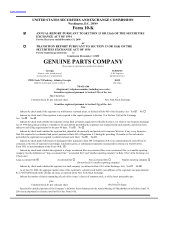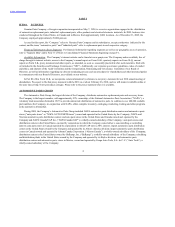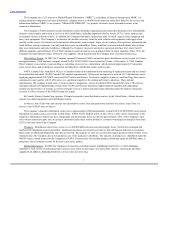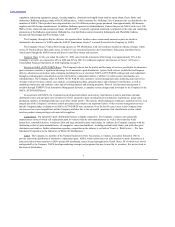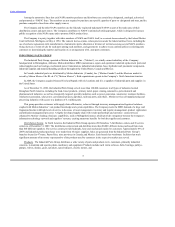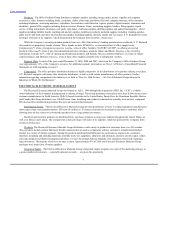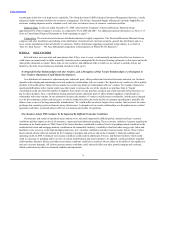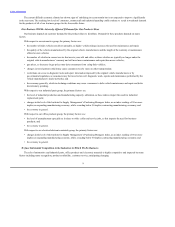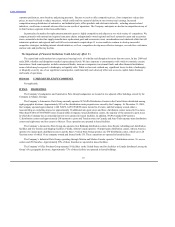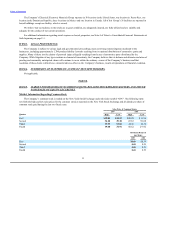Napa Auto Parts 2009 Annual Report Download - page 8
Download and view the complete annual report
Please find page 8 of the 2009 Napa Auto Parts annual report below. You can navigate through the pages in the report by either clicking on the pages listed below, or by using the keyword search tool below to find specific information within the annual report.
Table of Contents
to participate in this low-cost, high-service capability. The Group developed AIMS (Advanced Inventory Management System), a totally
integrated, highly automated solution for inventory management. The Group’s Integrated Supply offering also includes SupplyPro, an
electronic vending dispenser used to eliminate costly tool cribs, or in-house stores, at customer warehouse facilities.
Segment Data. In the year ended December 31, 2009, sales from the Company’s Electrical/Electronic Materials Group
approximated 3% of the Company’s net sales, as compared to 4% in 2008 and 2007. For additional segment information, see Note 11 of
Notes to Consolidated Financial Statements set forth beginning on page F-1.
Competition. The electrical and electronics distribution business is highly competitive. The Electrical/Electronic Materials Group
competes with other distributors specializing in the distribution of electrical and electronic products, general line distributors and, to a
lesser extent, manufacturers that sell directly to customers. Further information regarding competition in the industry is set forth in
“Item 1A. Risk Factors — We Face Substantial Competition in the Industries in Which We Do Business.”
Set forth below are some risks and uncertainties that, if they were to occur, could materially and adversely affect our business or
could cause our actual results to differ materially from the results contemplated by the forward-looking statements in this report and in the
other public statements we make. These risks are not exclusive, and additional risks to which we are subject to include, but are not
limited to, the risks of our businesses described elsewhere in this report.
As a distributor of automotive replacement parts, industrial parts, office products and electrical/electronic materials, our business
depends on developing and maintaining close and productive relationships with our vendors. We depend on our vendors to sell us quality
products at favorable prices. Many factors outside our control may harm our relationships with our vendors. For example, financial or
operational difficulties with a vendor could cause that vendor to increase the cost of the products we purchase from it. Vendor
consolidation could also limit the number of suppliers from which we may purchase products and could materially affect the prices we
pay for these products. Also, consolidation among automotive parts, industrial parts or office product suppliers could disrupt our
relationship with some vendors. In our automotive business, the number of vendors could decrease considerably, and the prices charged
to us by the remaining vendors could increase, as vehicle production slows due to the decline in consumer spending and, possibly, the
failure of one or more of the large automobile manufacturers. We would suffer an adverse impact if our vendors limit or cancel the return
privileges that currently protect us from inventory obsolescence. A disruption of our vendor relationships or a disruption in our vendors’
operations could have a material adverse effect on our business and results of operations.
Our business and results of operations may continue to be adversely impacted by difficult global, national and local economic
conditions and their impact on levels of consumer, commercial and industrial spending. These economic conditions began to significantly
deteriorate in the fourth quarter of 2008. Some of the factors that have contributed to reduced levels of spending include conditions in the
residential real estate and mortgage markets, conditions in the automobile industry, variability in fuel and other energy costs, labor and
healthcare costs, access to credit, high unemployment rates, low consumer confidence and other macroeconomic factors. These factors
had a material adverse effect on demand for the Company’s products and services and on the Company’s financial condition and
operating results in 2009. Continued recessionary conditions could result in additional job losses and business failures, which could
result in a decrease in spending and/or our loss of certain small business and retail customers. In addition, continued distress in global
credit markets, business failures and other recessionary conditions could have a material adverse effect on the ability of our suppliers to
meet our inventory demands. All of these macroeconomic conditions could adversely affect our sales growth, margins and overhead,
which could adversely affect our financial condition and operations.
8

